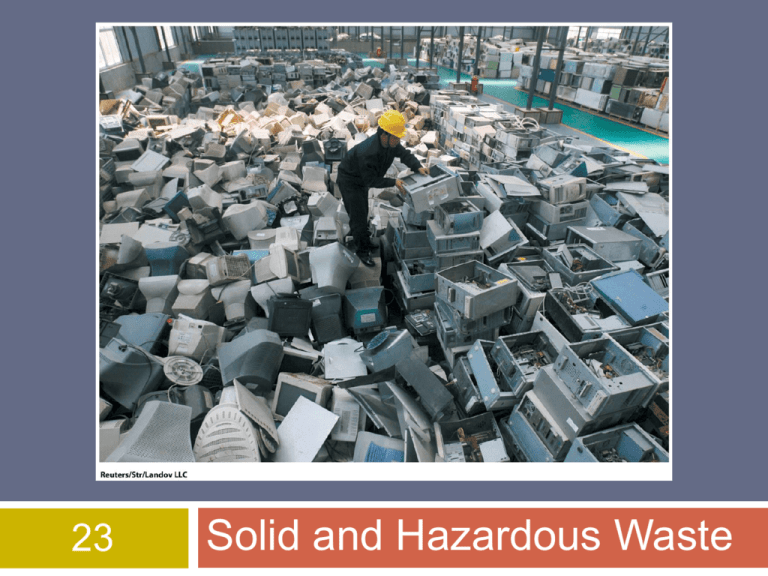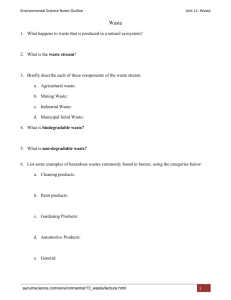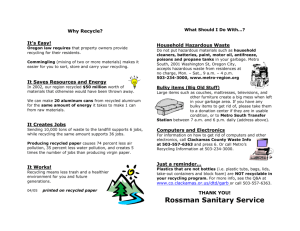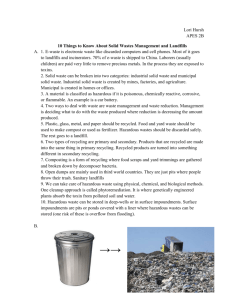
23
Solid and Hazardous Waste
Solid Waste
US generates more solid waste per capita than any
other country
1.98kg
(4.34lb) per person per day
243 million tons in 2009 (down from 2007)
3 largest waste generators in the US
agriculture,
industry & mining.
Waste generation is highest in developed countries
Instead
of repairing items, they are replaced
Types of Solid Waste
Municipal solid waste
Solid
material discarded by homes, office buildings,
retail stores, schools, etc.
Relatively small portion of solid waste produced
Non-municipal solid waste
Solid
waste generated by industry, agriculture, and
mining
Composition of Municipal Solid Waste
Largest single
component of
waste in the
USA
Municipal solid waste,
commonly known as
trash or garbage, refuse
or rubbish is a waste type
consisting of everyday
items that are discarded
by the public.
Ex: Offices, restaurants,
schools, retail stores,
your homes……
Disposal of Solid Waste
Three methods
Sanitary
Landfills
Incineration
Recycling
Sanitary Landfill
Compacting & burying waste under a shallow layer of soil
Most common method of disposal
Over
half of the waste in the US is disposed of this way
Problems
Methane
gas production by microorganisms
Contamination of surface
water & ground water by
leachate
Not a long-term remedy
Few new facilities being
opened
Closing a full landfill is
very expensive
Why Sanitary Landfills are Better
than Open Dumps
Open dumps do not have clay liners to help prevent
leaching into ground water
Not covered by soil = More offensive odors
They do not have systems to catch leachate
See
next page for more info on Leachate
Sanitary landfills have fewer rodents
One issue with sanitary landfills
Sanitary
landfills do have the potential for methane gas
explosions
Leachate
When water percolates through the waste, it promotes
and assists the process of decomposition by bacteria
and fungi.
when it emerges from a typical landfill site is a strongly
odoured black, yellow or orange coloured cloudy liquid.
The smell is acidic and offensive
© 2012 John Wiley & Sons, Inc. All rights reserved.
Special Problems
Plastic
Much
of plastic is from packaging
Chemically stable and do not readily break down and
decompose
Tires
Made
from materials that cannot be recycled
Can be shredded / incinerated
Tire Derived Products
roof
shingles, running tracks, flooring, playground equipment,
trash cans
Collect
rain water and become a breading ground fro
mosquitos
TDP
Incineration
Produced heat can make steam
Steam
to generate electricity
Produces less carbon emissions than fossil fuel plants
Good for paper, plastics and rubber
Problems with incineration
Production
of hazardous air pollutants
Carbon
monoxide, particulates, heavy metals
Reduced by (Lime Scrubbers & Electrostatic Precipitators)
Byproduct
Must
- Bottom ash and Fly ash
be disposed of in hazardous waste landfills
Types of Incinerators
Mass burn (below), Modular, Refuse-derived
Composting
Municipal Solid Waste Composting
Food
scraps, Sewage sludge, Agricultural manure,
Yard waste
Reduces yard (organic) waste in landfills
Can be sold or distributed to community
Landscapers,
green houses, golf courses, farmers
Or on a small scale – used in your own garden
Waste Prevention
Three Goals
Reduce
the amount of waste
Purchase
Reuse
Don’t
products with less packaging
products
just throw it away
If your not going to use it may be someone else will??
Recycle
Most
materials
cities and comunities have recycling and you can get
cash money for it. (you pay CRV go get your money back)
California Redemption Value
Reducing Waste
Source reduction
Products
designed and manufactured to decrease the
volume of solid waste
Reuse and recycle wastes at the plant where they are
generated
Pollution Prevention Act (1990)
reduce the amount of pollution at the point of origin
Dematerialization
Progressive
decrease in the size and weight of a
product as a result of technological improvements
Reusing Products
Refilling glass beverage bottles used to be
standard
Heavier
glass required in reusable glass bottles- costs
more to make and transport
Cheaper to use lightweight, non-reusable glass
Japan recycles almost all bottles
Reused
20 times
11 US States have deposits on cans and bottles to
promote reuse
Recycling Materials
Every ton of recycled paper saves:
17
trees
7000 gallons of water
4100 kwatt-hrs of energy
3 cubic yards of landfill space
Recycle
Glass
bottles, newspapers, steel cans, plastic bottles,
cardboard, office paper
Food waste is not recyclable!!!
Non-proteins
are compostable
Recycling
US recycles 38% of
Municipal Solid Waste
Recycling Paper
US
recycles 62.1%
This has increased due to
consumer demand for
recycled paper products
Recycling Glass
US
recycles 25%
Costs producers less than
new glass (right)
Recycling
Recycling Aluminum
Making
new can from recycled one costs far less than
making a brand new one (economic incentive)
51% of aluminum was recycled in 2009
Recycling Metals other than Aluminum
Lead,
gold, iron, steel, silver and zinc
Metallic composition is often unknown
Makes
recycling difficult
Recycling
Recycling Plastic
14%
of all plastic is recycled
(2009)
Less
expensive to make from
raw materials
28%
of PET in water and soda
bottles is recycled
Most plastic containers are
made of many types of plastic
that must be separated to be
recycled
Integrated Waste Management
© 2012 John Wiley & Sons, Inc. All rights reserved.
Hazardous Waste
Any discarded chemical that
threatens human health or
the environment
Reactive,
corrosive, explosive
or toxic chemicals
1% of waste stream in US
Love Canal Toxic Waste Site
© 2012 John Wiley & Sons, Inc. All rights reserved.
Hazardous Waste
© 2012 John Wiley & Sons, Inc. All rights reserved.
Hazardous Waste
Dioxin
Formed
as byproduct of combustion of chlorine
compounds
Bioaccumulate and biomagnify through foodweb
Cause cancer, effect reproductive, immune and
nervous system in animal testing (human results are
conflicting)
PCBs
Used
as cooling fluid, fire retardant, lubricator
Disposed
of in open dumps, sewers and fields in 1970s issue in groundwater today
Endocrine
disrupter
Management of Hazardous Waste
Chemical accidents
National
Response Center notified
Typically involves oil, gasoline or other petroleum spill
Current Management Policies
Resource
Conservation and Recovery Act (1976, 1984)
Comprehensive Environmental Response,
Compensation, and Liability Act (1980)
Commonly
known as Superfund
Superfund Program
Cleaning up existing hazardous waste:
400,000
waste sites
Leaking chemical storage tanks and drums (below
Pesticides
dumps
Piles of mining wastes
National Priorities List - 2011: 1,290 sites on the list
States with the greatest number of sites
New Jersey (112)
Pennsylvania (95)
California (94)
New York (87)
Michigan (67)
Management of Hazardous Waste
Biological Treatment of Hazardous Chemicals
Bioremediation
- use of plants, bacteria and other
microorganisms to break down hazardous waste into
relatively harmless products
1000
species of bacteria and fungi
Time consuming
Inexpensive
Phytoremediation-
use of plants to absorb and
accumulate hazardous materials in the soil
Ex:
Indian mustard removes heavy metals
Examples of Phytoremediation
© 2012 John Wiley & Sons, Inc. All rights reserved.
Hazardous Waste Landfill
© 2012 John Wiley & Sons, Inc. All rights reserved.
Reduce, reuse & recycle










